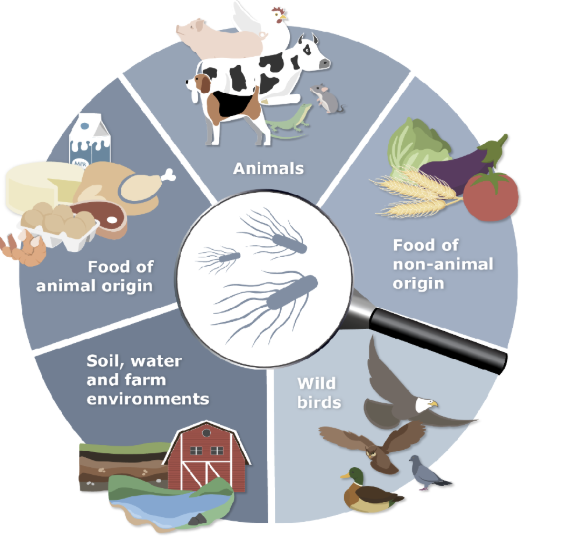salmonella
1/19
There's no tags or description
Looks like no tags are added yet.
Name | Mastery | Learn | Test | Matching | Spaced |
|---|
No study sessions yet.
20 Terms
what family does salmonella belong to
Enterobacteriaceae family
what are the genus
two species: S. bongori and S. enterica

is it gram - or positive
gram -
shape
motile rod
growth temp
5-47°C, with an optimum at 37°C
minimum water acitivty
0.93
type of organism
Mesophile
Vegetative Cells (Non-Sporeformers)
survival
can survive for extended periods at even lower Aw values
Protection against gastric acid by food matrix, e.g. in fatty products
disease
Salmonellosis (Non-Typhoidal)
The illness caused by Salmonella is generally known as Gastro-enteritis
symptons
abdominal pain, nausea/vomiting, and diarrhoea
Sometimes: Sequelae (long-term complications) can develop, such as Reactive arthritis (affecting joints)
incubation time
1-2 days
ilness duration
3-7 days
D/R dose response
is usually quite high, though it can sometimes be low
seasonal trend
There is a seasonal trend- may be related to temperature
transmission and sources
commonly found in food of animal origin, such as meat, poultry, raw milk, eggs, and (shell)fish
A notable risk is from undercooking eggs
Salmonella can persist in food factories (e.g., as "house flora" on processing machines) and in stables where production animals like broilers are raised
Darkling beetles can act as a vector, bypassing cleaning efforts in broiler houses and allowing Salmonella to persist.
Environmental cycle is hard to break

prevention and control
At the farm level: Implement national control programs, hygiene measures, separate animals from the outside, ensure Salmonella-free feed and water, and use vaccination.
To limit spread of contamination: Comply with microbiological criteria, practice logistic slaughter, and use hygienic equipment design.
General hygiene: Good general hygiene practices (GHP) in factories and retail, along with proper training, are essential.
Food preparation: Proper heating and storage (maintaining the cold chain) at retail, catering, and by consumers are vital.
heating to 70 °C is best method for reducing Salmonella, as demonstrated by the reduction of CFU/g in egg yolks with increased boiling times
Even after being ill and recovering person is still a carrier for several days/months. Carriers can be treated with antibiotics
D value
D-values vary significantly between different Salmonella strains/serotypes and are influenced by the food matrix:
factors affecting D value
D-values are lower at higher temperatures (faster inactivation).
Low water activity (aw) and high fat content increase the D-value, meaning more heat is required for inactivation
z value
The z-value for vegetative cells like Salmonella is typically around 5°C, meaning a 5°C increase in temperature can lead to a 1-log (90%) reduction in the D-value
mortality rate
low less than 1 percent